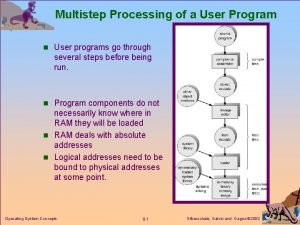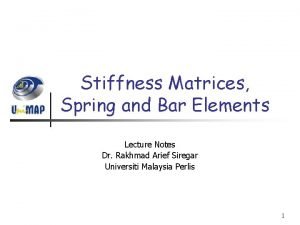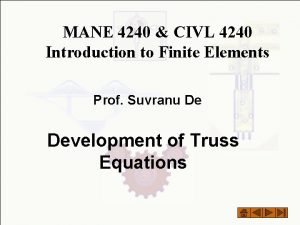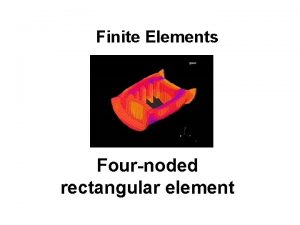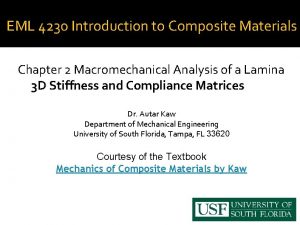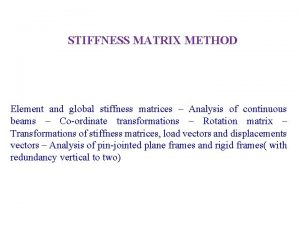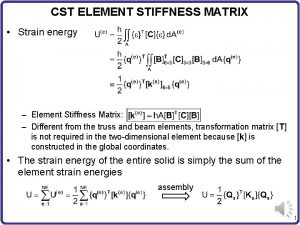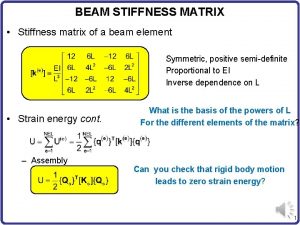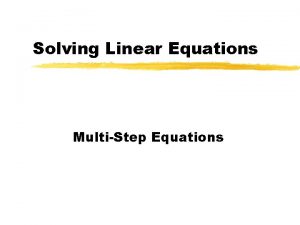Stiffness and Multistep Methods Chapter 26 Two areas










- Slides: 10

Stiffness and Multistep Methods Chapter 26 • Two areas are covered: – Stiff ODEs will be described - ODEs that have both fast and slow components to their solution. – Implicit solution technique and multistep methods will be described. by Lale Yurttas, Texas Chapter 26 A&M University Copyright © 2006 The Mc. Graw-Hill Companies, Inc. Permission required for reproduction or display. 1

Stiffness • A stiff system is the one involving rapidly changing components together with slowly changing ones. • Both individual and systems of ODEs can be stiff: • If y(0)=0, the analytical solution is developed as: by Lale Yurttas, Texas Chapter 26 A&M University Copyright © 2006 The Mc. Graw-Hill Companies, Inc. Permission required for reproduction or display. 2

Figure 26. 1 by Lale Yurttas, Texas Chapter 26 A&M University Copyright © 2006 The Mc. Graw-Hill Companies, Inc. Permission required for reproduction or display. 3

• Insight into the step size required for stability of such a solution can be gained by examining the homogeneous part of the ODE: is the solution. • The solution starts at y(0)=y 0 and asymptotically approaches zero. by Lale Yurttas, Texas Chapter 26 A&M University Copyright © 2006 The Mc. Graw-Hill Companies, Inc. Permission required for reproduction or display. 4

• If Euler’s method is used to solve the problem numerically: The stability of this formula depends on the step size h: by Lale Yurttas, Texas Chapter 26 A&M University Copyright © 2006 The Mc. Graw-Hill Companies, Inc. Permission required for reproduction or display. 5

• Thus, for transient part of the equation, the step size must be <2/1000=0. 002 to maintain stability. • While this criterion maintains stability, an even smaller step size would be required to obtain an accurate solution. • Rather than using explicit approaches, implicit methods offer an alternative remedy. • An implicit form of Euler’s method can be developed by evaluating the derivative at a future time. by Lale Yurttas, Texas Chapter 26 A&M University Copyright © 2006 The Mc. Graw-Hill Companies, Inc. Permission required for reproduction or display. 6

• Backward or implicit Euler’s method The approach is called unconditionally stable. Regardless of the step size: by Lale Yurttas, Texas Chapter 26 A&M University Copyright © 2006 The Mc. Graw-Hill Companies, Inc. Permission required for reproduction or display. 7

by Lale Yurttas, Texas Chapter 26 A&M University Copyright © 2006 The Mc. Graw-Hill Companies, Inc. Permission required for reproduction or display. 8

Multistep Methods The Non-Self-Starting Heun Method/ • Huen method uses Euler’s method as a predictor and trapezoidal rule as a corrector. • Predictor is the weak link in the method because it has the greatest error, O(h 2). • One way to improve Heun’s method is to develop a predictor that has a local error of O(h 3). by Lale Yurttas, Texas Chapter 26 A&M University Copyright © 2006 The Mc. Graw-Hill Companies, Inc. Permission required for reproduction or display. 9

Multistep Methods Corrector formula and you iterate until a maximum number of iteratios is reached. by Lale Yurttas, Texas Chapter 26 A&M University Copyright © 2006 The Mc. Graw-Hill Companies, Inc. Permission required for reproduction or display. 10
 List of goals to set for yourself
List of goals to set for yourself Multi step processing of a user program
Multi step processing of a user program Ras oncogene
Ras oncogene Clausola multistep
Clausola multistep Toughness on a stress strain curve
Toughness on a stress strain curve Component of accenture delivery suite
Component of accenture delivery suite Bar stiffness matrix
Bar stiffness matrix Difference between osteoarthritis and rheumatoid arthritis
Difference between osteoarthritis and rheumatoid arthritis Transformation matrix
Transformation matrix Rectangular element stiffness matrix
Rectangular element stiffness matrix Monoclinic material stiffness matrix
Monoclinic material stiffness matrix

